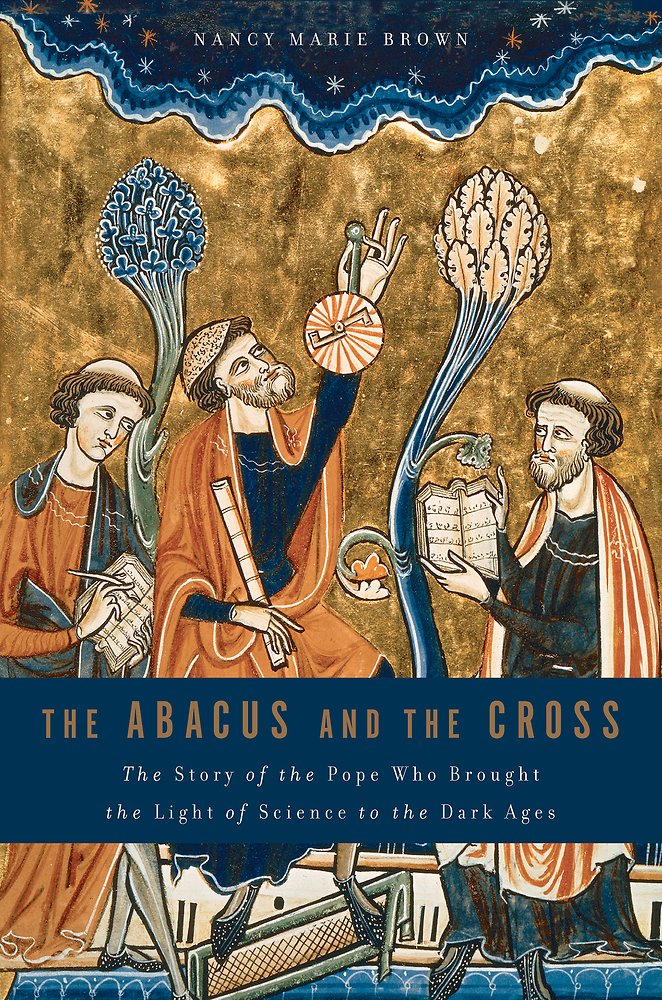 Article
Article- 800 words
- Level: all audiences
Fr. Paul Mueller, S. J., of the Vatican Observatory reviewed the book The Abacus and the Cross, The Story of the Pope Who Brought the Light of Science to the Dark Ages, by Nancy Marie Brown. The book concerns Gerbert of Aurillac, later Pope Sylvester II, a mathemetician at the end of the first millennium. Fr. Mueller’s review appeared in Physics World, Volume 24, Number 10:
The Abacus and the Cross is a book with a hero and a villain. The hero is Gerbert of Aurillac, the 10th century shepherd boy who became monk, schoolmaster, scientist, mathematician, and abbot, and then reigned at the turn of the first millennium as Pope Sylvester II. Gerbert was the first to introduce Arabic numerals to Europe, using them on his abacus; he wrote a leading textbook on geometry, which was supplanted only after 200 years when full translations of Euclid became available in the West; and he constructed and used astronomical instruments such as armillary spheres and astrolabes. Little remains of his own writings. Evidence for his genius can be inferred for the most part only indirectly, by examining how his knowledge spread to his students. His achievement is also complicated by his popular reputation as a “devil’s tool” and master of dark arts – which Brown insists is inaccurate and unfair.
The villain is Gerbert’s lifelong intellectual and political enemy, Abbo of Fleury. Like Gerbert, Abbo became monk, schoolmaster, scientist, mathematician, and abbot. Abbo was not a pope, but he has been named a saint. For Brown the most crucial difference between the two men is that Gerbert showed great creativity, introducing a whole new tradition in mathematics and science, in a manner distinctively modern and “experimental,” whereas Abbo was anything but creative: the copious written works he left behind are “disappointingly derivative,” involving merely “well-organized rearrangements of sources common used” to create a “fine and tidy summation.”
Brown’s style is more Abbo than Gerbert. She capably synthesizes other scholars’ evaluations and translations of the primary source materials, but the ample notes at the end of the book do not give evidence of direct work with primary sources from Gerbert, Abbo, or their contemporaries.
Brown compensates for the lack of documentary evidence concerning Gerbert’s life by describing in substantial detail what life would have been like for someone like Gerbert. This includes detailed notes on the typical diet, style of life, and pattern of education of a monk; the manufacture and use of parchment, paper, and ink; the construction and use of books; and the processes and dangers involved in travel.
Her summary of Gerbert’s accomplishments in mathematics and science whets the appetite, but will not satisfy a reader with some scientific background. Brown describes what Gerbert could do with his abacus and other instruments, but she does not discuss in any detail how he could do these things.
Her outline of Gerbert’s political entanglements and his ascent to the papacy will be difficult to follow for a scientifically-minded reader without a background in turn-of-the-millenium history and intrigue. Brown’s account is more about what happened (with many names and dates) than about why. Most frustrating is Brown’s account in Chapter 9 of a “figurative poem” which was written by Gerbert. Brown communicates that this was an extraordinary accomplishment, marvelously complex and well worth exploring, but she does not help her reader to enter into the poem and its complexities in any serious way. Brown sets the table, but she does not serve the meal.
Three themes run through this book. First, Gerbert’s work in mathematics and science serves to show that the Dark Ages weren’t all that dark: creative things were happening, knowledge was advancing, and math and science were already rational and experimental. Second, science and religion are not (and were not) really at war; Gerbert himself is an important example of a religious person who also did first-rate work in mathematics and science. Only much later did Petrarch, Washington Irving, William Whewell, John Draper, and Andrew Dickson White construct the whiggish notion of an eternal war between science and religion, by circulating the charge that religious people persisted in the uncritical belief that the earth is flat, not round (a version of history that Brown goes to great lengths to refute). And finally: if only Gerbert’s hopes and ideals had been realized, history would be different: religion and science would be one, and science would bridge the tensions and differences that separate Christianity, Islam, and Judaism. But Brown displays a whiggish tendency of her own. She accepts and employs without critical comment the Enlightenment notion of science as an enterprise that is straightforwardly and simply rational and experimental.
This book represents an intellectually honest, good-faith effort to portray Gerbert and his accomplishments at a popular level. But both scientifically and theologically minded readers can only echo her own plaint of “what-if.” If only she had gotten inside the scientific issues. It would have been fun, for example, to hear in some technical detail how Gerbert’s Abacus actually worked, or for that matter how his “figurative poem” played out on multiple levels of meaning. Or if only she had gotten inside the theological issues. It seems strange for a book concerned with debunking the notion of a “war” between science and religion to take no account of theological issues. But Brown deals with religion only as an institutional and sociological force; in this book, the only place the Cross shows up is in the title.
Click here to read the full article from IOP Science/Physics World.
